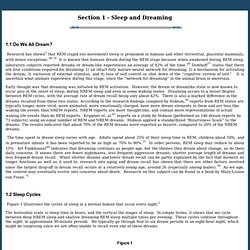

Stages. Theorists. Dream. Dreams mainly occur in the rapid-eye movement (REM) stage of sleep—when brain activity is high and resembles that of being awake.

REM sleep is revealed by continuous movements of the eyes during sleep. At times, dreams may occur during other stages of sleep. However, these dreams tend to be much less vivid or memorable.[3] The length of a dream can vary; they may last for a few seconds, or approximately 20–30 minutes.[3] People are more likely to remember the dream if they are awakened during the REM phase.
The average person has three to five dreams per night, but some may have up to seven dreams in one night.[4] The dreams tend to last longer as the night progresses. Opinions about the meaning of dreams have varied and shifted through time and culture. Cultural meaning[edit] Ancient history[edit] The Sumerians in Mesopotamia left evidence of dreams dating back to 3100 BC. In ancient Egypt, as far back as 2000 BC, the Egyptians wrote down their dreams on papyrus. Classical history[edit] What Parts Of The Brain Produce Dreams? When Sigmund Freud began investigating dreams 100 years ago, he assumed that dreaming involved many parts of the brain.

While the modern science of dreaming has disproved much of Freudian theory, neuroscientists widely accept his central premise that dreams are meaningful expressions of the mind-brain system. The lower, middle and higher brain all contribute to dreaming cognition, making dreams a weird but fruitful object of study. The oldest part of the brain, shared by all vertebrates, is the brain stem. In 1977, Allan Hobson and R McCarley discovered that electrochemical pulses from the brain stem create the stage of sleep in which most dreams occur. Known as REM, which stands for rapid eye movement, this stage of sleep guides the paralysis of all voluntary muscle groups, except for the eyes. When dreaming sleep begins, the middle brain "lights up" with activity. Why don't we realize when dreaming that monsters, ghosts and goblins are not real? Science of Dreaming - Section 1 - Robert J Hoss.
Section 1 - Sleep and Dreaming 1.1 Do We All Dream?

Research has shown1 that REM (rapid eye movement) sleep is prominent in humans and other terrestrial, placental mammals, with minor exceptions.38,79 It is known that humans dream during the REM stage because when awakened during REM sleep, laboratory subjects reported dreams or dream-like experiences an average of 82% of the time.39 Domhoff77 states that there are four conditions required for dreaming: 1) an intact fully mature neural network for dreaming; 2) a mechanism for activating the dream; 3) exclusion of external stimulus; and 4) loss of self control or shut down of the “cognitive system of self.” It is uncertain what animals experience during this stage, since the “network for dreaming” in the animal brain is uncertain. Early thought was that dreaming was initiated by REM activation. However, the dream or dreamlike state is now known to occur also at the onset of sleep, during NREM sleep and even in some waking states. Figure 1.